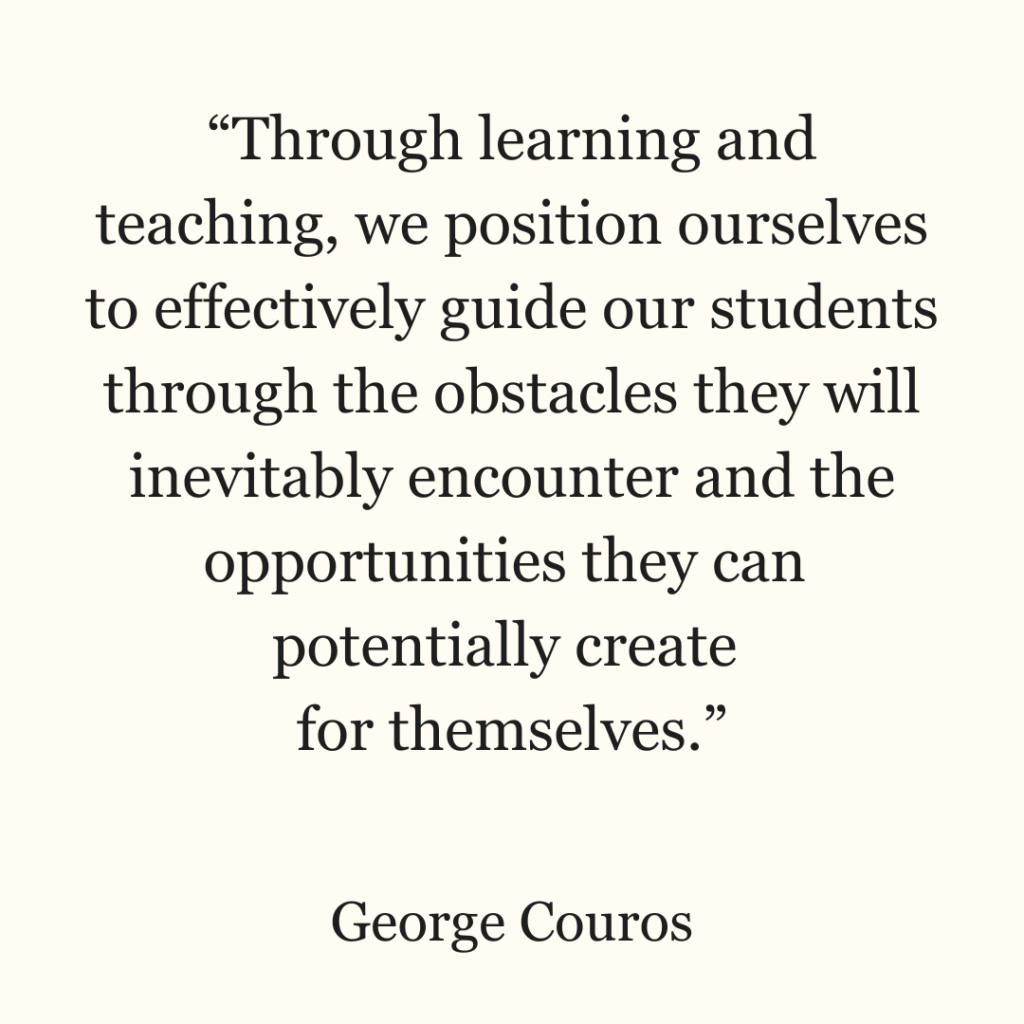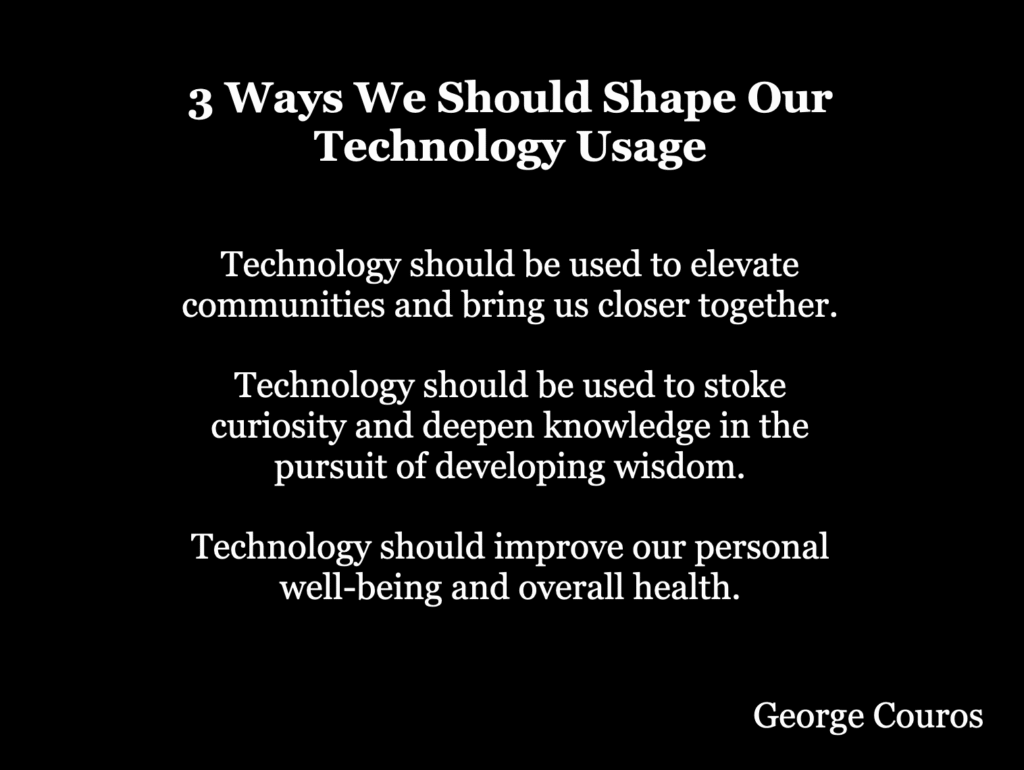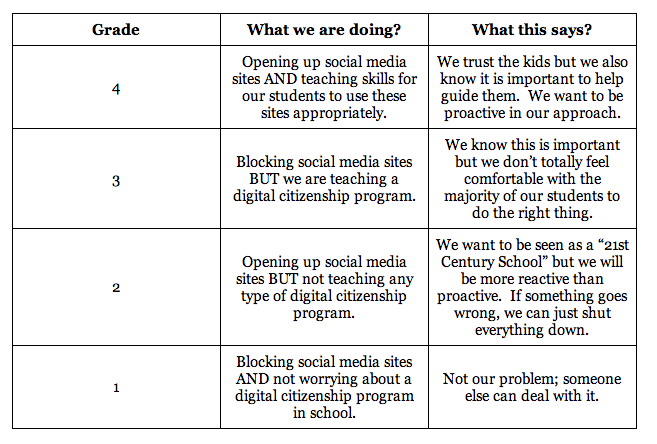
A few weeks ago, I wrote an email newsletter on how, if we are not cognizant, technology can shape our behaviors (you can read the entire article here). However, through intentionality and awareness, we should strive to shape our use of technology.
The three main points in the article are listed below:

Today, I want to address the last point: “Technology should improve our personal well-being and overall health.”
Now, I can provide an example of how I’ve learned strategies for healthy eating that have helped me over the past several years. For example, exercise programs either found through searches or created and personalized through ChatGPT have elevated my training. I have also significantly improved my eating habits by focusing on high-protein and high-fiber diets, which I would have never discovered if I hadn’t followed fitness accounts. These things have helped me tremendously.
But I think it is also not about what you can add with technology, but what you can subtract that is essential.
Pulling Back from Technology for Personal Well-Being
As I have shared before, I have dealt with depression and anxiety most of my adult life, and I think technology has hurt that. For example, I am very aware not only of how much time I spend on social media, but also who I connect with. If you are someone who is perhaps rude to others, complains often, or creates a space for complaints, I have no time for that.
Now, I am not saying you can’t do those things, but for my own mental health, I can’t be around that type of environment. Not only does it affect me, but it can also impact my “offline” interactions with friends and family. This rule of who I surround myself with is not limited to how I interact online. As the saying goes, you are the average of the five people you surround yourself with, and I want to improve, regardless of the space.
However, I also take a step further by ensuring that I have zero notifications sent to my phone. This includes not only social media interactions, but also text messages and phone calls.
It is weird to think that the ringing of a telephone or a doorbell was such a source of joy as a child growing up in the 80s, and has become such a stressor today. Perhaps because it was much rarer and more personal back then. The anxiety I had as a kid to call someone I had a crush on and having to talk to their parents was probably good for me. The thought of a spam call or an unwanted solicitor (is there wanted solicitors?) is not going in the same category. The latter experience doesn’t make me better, but rather more distrustful.
Once I turned off all notifications, I felt so much less anxiety and an increased calm in my life. Yet, this wasn’t me “shaping” my technology but unshaping what it had done to me. I go to my devices when I decide, not when they bring me to them.
Do we guide technology usage from a place of experience?
You might be reading this and thinking, “Well, you can do that, but I couldn’t do my job without having my notifications on!” and that might be true for some professions, but is it all of them? Is it yours? Were you able to do your work or live your life before having non-stop pings coming your way? I don’t know the answer for you, but I think it is a question worth considering.
This all being said, I still use my phone and social media. Not only have I used these things, but I have also directly benefited from their usage. Each week, this blog reaches educators worldwide, and no matter how many times I receive a message from someone outside North America, I still marvel at how small the world has become when we leverage these opportunities at our fingertips.
The other thing you don’t see happening right now is that I am sitting in a Starbucks and struggling with my reflection because I know that YOU are going to be reading this. Am I honoring different perspectives? Am I making my ideas and thinking clear? Am I communicating my own struggles with these ideas when I am uncertain? Knowing that anyone in the world can read this has made me much more reflective and empathetic to the viewpoints of others. That is an aspect of social media that we often overlook, but we should always consider.
I bring this all up because I think it is essential to teach our kids, from a place of credibility, how to use these things and how not to use them.
Are there any potential long-term benefits from using social media and technology?
I remember reading this quote from “The Anxious Generation,” and it struck me:
“We don’t let preteens buy tobacco or alcohol, or enter casinos. The costs of using social media, in particular, are high for adolescents, compared with adults, while the benefits are minimal.”
I could not agree more that we shouldn’t be letting kids smoke and drink while betting on horses. I suppose my concern is whether these practices can improve our lives? Is social media like cigarettes, and phones like alcohol? Probably the built-in addictive qualities are a great comparison to these tools, but I am not really sure there are any benefits to those vices in adulthood.
Now, I know I may be a bit of a prude in making this statement, and if you want to argue that there are benefits to these things, I am open to hearing that perspective. For me personally, I see zero benefits to using these things to create positive long-term outcomes, although I have had alcohol in my life and have gambled. The same is true with cookies; I love them and eat them, and in the moment, they make me feel good, but long-term, are there any potential benefits to eating those absolutely delicious snacks? If there is, please make that argument because I am here for it!
I am not judging others for their own choices, as I hope others won’t judge mine. As I learned in high school French class, chacun son goût (to each their own).
I am not advocating for perfection or the absence of vices. I would be hypocritical if I had that perspective.
My thought process is, are there any benefits to social media or device usage in the future? I would say that even Jonathan Haidt, the author of the book, would agree that there is, as he (and probably his team) relentlessly shares their viewpoints through technology with millions around the world and has made significant inroads by sharing these perspectives.
Personally, although I am aware of the negatives associated with this technology’s usage, I struggle to advocate against something that has personally benefited me. The kids would call this “gatekeeping,” and I wouldn’t even know that term if I weren’t on social media.
Ultimately, the perspective I am trying to convey is this: there are many negatives to this technology, as well as positives.
A focus of mine is that, through learning these things myself, not only do I believe that we can (and should) teach our students and children this, but they also see that we have credibility through our own experience. I am not giving my own kids phones and signing them up for TikTok accounts at an early age, nor am I advocating for or against phone bans in schools. That is not a choice for me to make, and I do not know the context or needs of your community as well as you do, reading this. However, you can be assured that I will teach my own children about these things and strive to show them both the potential and the pitfalls. There have been numerous issues, not only with young people but also with adults, regarding the use of technology.
Something to consider in the cause of these issues: is it because we overtaught technology usage in schools, or the opposite? I am not referring to the usage rates of devices by students in schools, but rather the focus on not only proper usage, but also leveraging technology effectively.
I believe that, in many ways, we have seen the over-usage of technology in schools while under-teaching how to use these things positively. Both things can be true.
In 2013, I wrote a blog post titled, “Is your school’s ‘digital citizenship’ practice a pass or fail?” and shared the following rubrics for consideration:

Looking at this now, I am not sure I fully agree with what I wrote in 2013, but I also know I don’t entirely disagree. For example, I love hearing from schools that, with reduced technology, they are seeing students not only more engaged with their learning, but also with each other. This is a great thing, and I want more of that.
But here is another consideration.
If we are trying to help kids transition to the subsequent phases of their lives, and we all know they will be vetted by their online presence for potential jobs or post-secondary institution applications, are we helping them by not doing this in schools?
As an alternative viewpoint, if we know that all students in schools today will be searched online, what is the benefit of teaching them to post positive things so that when they are found, people say, “This is someone I want as a part of my organization!” The solutions to all of this are not necessarily either/or but somewhere in the middle. In that same 2013 post, I referenced an article from Dan Haesler titled “Driving down Social Media Way,” where he argues that if we looked at how we teach social media to young people the same way we taught driving, there would be some dire repercussions.
These were his three main arguments:

Now, this post was written by Dan in 2013, so I can’t honestly say that his thinking hasn’t changed since then (similar to my own evolution on many of these ideas). Still, like many things in our world that scare us, I try to focus on emphasizing teaching as a way to solve problems, rather than ignoring the issues that currently exist.
Do we really need this technology in our lives?
I also believe that any person can live a very fulfilling and purposeful life without access to this technology, and I must admit that there are days when I wonder if we would all be better off without it. I don’t know the answer, but I do know we are very unlikely to find out. My goal is to help others figure that out for themselves. That can only be done through learning and teaching, in that order.
As you can see from my own writing, I struggle with my changing perspectives, but I do know the answer lies somewhere in the grey.
Pretending a problem doesn’t exist won’t make it go away, but ignoring the potential pitfalls of technology, as well as its opportunities, is not a great strategy.
Through learning and teaching, we position ourselves to effectively guide our students through the obstacles they will inevitably encounter and the opportunities they can potentially create for themselves.